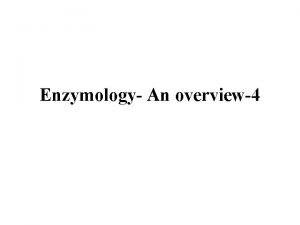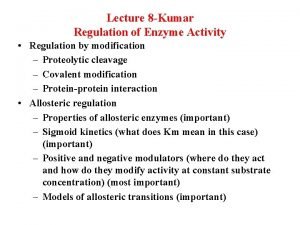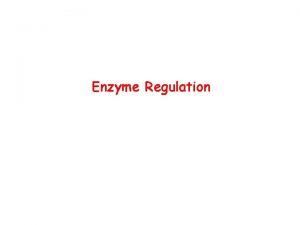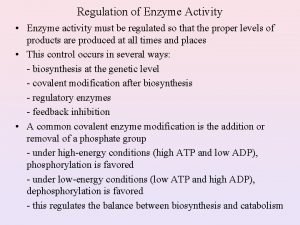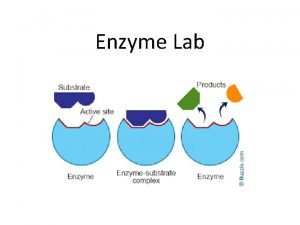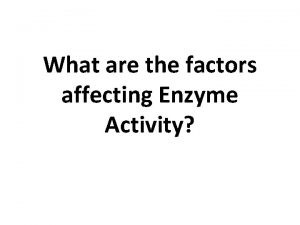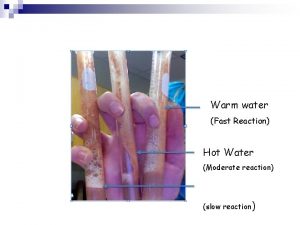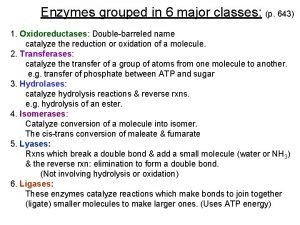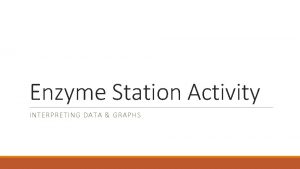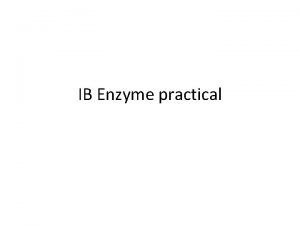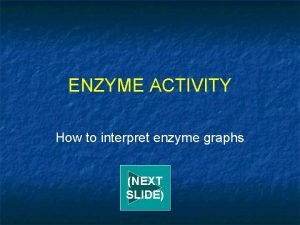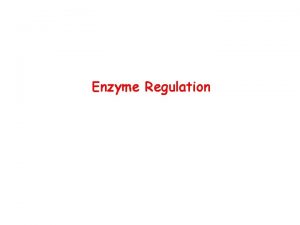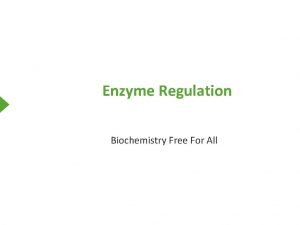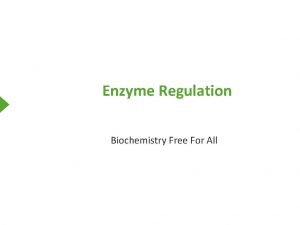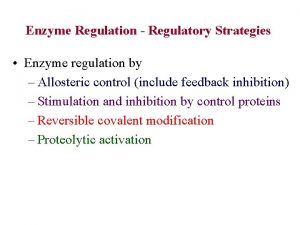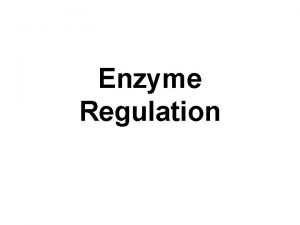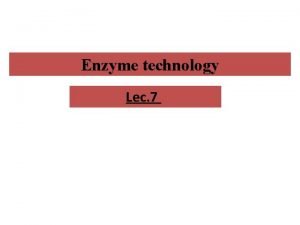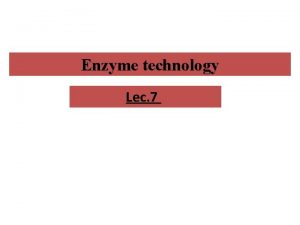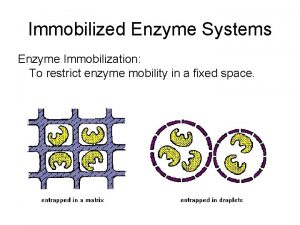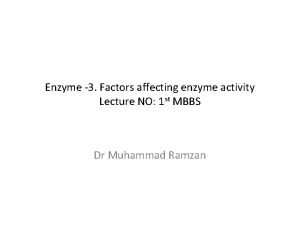Lecture 9 Enzyme Regulation Regulation of Enzyme Activity













- Slides: 13

Lecture 9 Enzyme Regulation

Regulation of Enzyme Activity • Enzyme quantity (regulation of gene expression) are controlled by: 1. Transcription. rate of biosynthesis/genetic control 2. Translation. 3. Enzyme turnover. - The overall synthesis and degradation of a particular enzyme. - The amount of enzyme can be increased by increasing its rate of synthesis, decreasing the rate of its degradation, or both. • Response time is between fractions of seconds to hours. • Four types of enzyme activity: 1. Allosteric regulation. 2. Covalent modification. 3. Proteolytic cleavage of proenzyme. 4. Association-disassociation.

Enzyme activity - Allosteric Regulation • Allosteric enzymes - from the Greek allos for "other" and stereos for "shape" (or site) meaning "other site". • Allosteric enzymes usually have quarternary structure (multiple subunits) and bind to site other than the active site. • Conformational changes in one part of an enzyme that then affect the overall conformation of the active site. - Causes an increase or decrease in activity. - These metabolites are called allosteric activators or allosteric inhibitors. • Efficient use of biosynthetic precursors and energy.

Enzyme activity - Allosteric Regulation • General effects of allosteric regulation: 1. A positive effector activates the enzyme (an activator). 2. A negative effector inhibits the enzyme (an inhibitor). • Vo vs [S] plots give sigmoidal curve for at least one substrate. - Binding of this allosteric inhibitor or this activator does not effect terminal enzymatic actions or Vmax, but does alter Km.

Enzyme activity - Allosteric Regulation • End products are often inhibitors. - Occurs when an end-product of a pathway accumulates. - The end-product binds to the regulatory enzyme at the start of the pathway and decreases its activity. - 1 st committed step of a biosynthetic pathway or enzymes at pathway branch points often regulated by feedback inhibition.

Enzyme activity - Allosteric Regulation • i. e. Phosphofructokinase(PFK). PFK catalyzes 1 st committed step in glycolysis. Phosphoenolpyruvate (PEP) is an allosteric inhibitor of PFK PEP

Enzyme activity - Covalent modification • Modification of catalytic or other properties of proteins by a modifying group to a specific functional group on the enzyme. - phosphoryl (most common), uridylyl, ADP-ribosyl and methyl. • Modifications are removed by catalytic activity of a different enzyme. - enzyme can cycle between active and inactive states. • Require one enzyme for activation and another for inactivation. • Reversible regulatory mechanism.

Enzyme activity - Covalent modification • Example - Phosphorylation/dephosphorylation most common covalent modification whereby a phosphate is transferred from an activated donor (usually ATP). Involve protein kinases/phosphatase. Amino acids with –OH groups are targets for phosphorylation. Phosphates are (-) charged groups which effect conformation. occurs in response to stimulus (hormone or growth factor).

Proteolytic cleavage of Enzyme activity - proenzyme • Also called Zymogen Activation. • Zymogens or proenzymes are inactive precursors of enzymes. • Activation involves the irreversible hydrolysis of one or more peptide bonds, resulting in an active form. • Conformational changes that either form an active site of the enzyme or expose the active site to the substrates. • A cascade reaction in general. • Some examples of zymogens: 1. Hormones: proinsulin. 2. Digestive proteins: trypsinogen. 3. Connective tissue proteins: procollagen. 4. Funtional proteins: factors of blood clotting and clot dissolution.

Proteolytic cleavage of Enzyme activity - proenzyme • Example - Production of insulin from proinsulin.

Proteolytic cleavage of Enzyme activity - proenzyme • Example - Production of trypsin from trypsinogen.

Proteolytic cleavage of Enzyme activity - proenzyme • Example - Blood clotting. - Clotting involves series of zymogen activations. - Seven clotting factors are serine proteases involved in clotting cascade reactions.

Enzyme Regulation by Enzyme activity - Association/Disassociation • Example - Acetyl-Co. A Carboxylase. - 1 st committed step in fatty acid biosynthesis. - Activated in the presence of citrate. - Inactivated in the presence of fatty acyl-Co. A.
 Enzyme regulation
Enzyme regulation Allosteric activator
Allosteric activator Covalent modification
Covalent modification Water soluble vitamins coenzymes
Water soluble vitamins coenzymes 01:640:244 lecture notes - lecture 15: plat, idah, farad
01:640:244 lecture notes - lecture 15: plat, idah, farad Enzyme cut-outs activity answer key
Enzyme cut-outs activity answer key Enzymeworks
Enzymeworks Enzyme cut-outs activity
Enzyme cut-outs activity 6 types of enzymes
6 types of enzymes What variables affect enzyme activity in each of the graphs
What variables affect enzyme activity in each of the graphs Factors affecting enzyme activity bbc bitesize
Factors affecting enzyme activity bbc bitesize Interpreting enzyme graphs
Interpreting enzyme graphs Activity coefficient
Activity coefficient Activity 2;
Activity 2;
